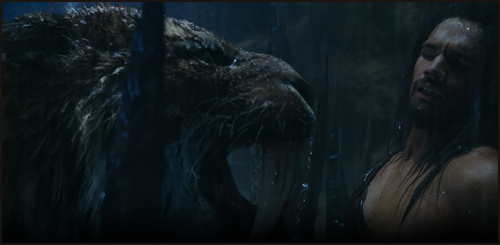Wired does Gygax
Wednesday, March 12, 2008
posted by Leo Grin

Wired has long been the best place to go to on the Internet for extraordinarily deep, well-written essays on issues important to my generation (I still consider one of their pieces, “The Doomslayer” by Ed Regis, the single most devastating essay against modern wacko-environmentalism I’ve ever read). Now Scott Oden has alerted me to their latest triumph, “Dungeon Master: The Life and Legacy of Gary Gygax.” Written by David Kushner, it is far and away the most in-depth and fascinating look at the creator of Dungeons & Dragons we’re ever likely to read, at least until the first full-on biography gets done. (Although not as spot-on about Gygax’s ingenuity as Kushner, Paul La Farge wrote a very fine article in 2006 for The Believer that covers some interesting areas of the story that Kushner glosses over, such as Gygax’s foray into Hollyweird decadence: living in King Vidor’s house in Beverly Hills, striking million-dollar deals, negotiating with a receptive Orson Welles to star in a D&D movie, and cavorting with beauty contestants in his jacuzzi. Who says D&D guys don’t have real-life fun?)
I discovered D&D as a sixth grader while on a week-long Boy Scout camping trip. How wonderful, then, to learn twenty-five years later via this article that D&D was created by men with ingrained sensibilities as patriotically American as apple pie. Witness the moving photo of Gygax the child saluting the flag, and the charming dedication to our country on the reproduced gaming program, which when you think about it was bravely written in the very face of the insane, take-no-prisoners counterculture movement of the late 1960s. And the whole story is infused with a heroic, Horatio Alger-like entrepreneurship — Alger’s pederasty aside, of course — that in its own way is as American as you can get. I marveled at the vast number of serendipitous discoveries Gygax made, the clever ways he seized on and integrated things from all aspects of his life into his imaginative dreamscape: wargames whose history dates back to H. G. Wells and beyond, the otherwise boring insurance company calculations used at his day job, stumbling on a catalogue containing “Platonic solids” such as icosahedrons — transformed by Gygax into twenty-sided dice. And of course, lurking in the background, fueling his drive towards merging fantasy with reality, there was the unforgettable and inspiring stories of Robert E. Howard:
In other war games, each miniature represented a unit — say, 10 or 20 men — and could be destroyed with a single successful attack. Gygax decided to make some of the miniatures in Chainmail represent a single character, designated “hero” or “superhero,” who could only be killed by several attacks. For the hell of it, Gygax included a supplemental set of rules that featured magical fantasy trappings: dragons, elves, wizards, and fireballs. He was a fan of the Conan the Barbarian books by Robert E. Howard and wanted to try to capture that sort of swashbuckling action in a war game.
Best of all, Kushner describes Gygax’s relentless, heroic struggle to let his imagination fly unfettered. He had to organize and fund conventions, endure ostracizing by his wargaming friends (who disdained the heresy of adding fantasy and magic to what they saw as realistic war simulations), and continually invest time, money, and ego on risky ventures with seemingly no chance of ever paying off. Nobody save Dave Arneson seemed to understand what he had — most of his fellow gaming friends didn’t get it, nor did the creative talent at gaming companies like Avalon Hill. My God, to think that Gygax was savvy enough to give the most famous RPG of all time the catchy, evocative, alluring name Dungeons & Dragons based on his gut trust in the effusions of a four-year-old girl! This is true genius at work — one man and a dream changing the world against all odds, step-by-perilous-step. It’s a great American success story, and Wired deserves immense credit for bringing it to light in such a magisterial essay.
Compare Wired‘s intelligent, learned, heartfelt coverage to the tripe Slate published on Gygax, and Kushner and Wired‘s achievement becomes all the more impressive. I’ve long seen online news magazines such as Slate and Salon as sort of anti-Wired, publications that veer all over the map in terms of quality, combining decent articles and opinion peices with monstrosities that cover their subjects in shallow, self-refuting ways. Too often the editors run essays that reek of ignorance and have absolutely nothing to recommend them, items penned by angry, bitter writers who take anarchistic delight in blithely pissing on things that millions of others consider sacred cultural touchstones. From The Searchers to to H. P. Lovecraft, the modus operandi of such authors entails stringing together as many derogatory, disdainful phrasings as they can muster into short attack pieces dripping with hate and scorn for their subjects.
And so it is with Gygax. To offset a decent if rather lackluster obituary by Johnathan Rubin, Slate has published a truly vile, thermonuclear philippic by Eric Sofge that dismisses Dungeons & Dragons as “sociopathic storytelling,” a “collective fantasy of massacre and greed” where poor defenseless Third World minorities like Orcs and Hobgoblins are mercilessly slaughtered by the fantasy equivalent of American imperialists in the name of treasure and experience points. To Sofge, Gygax’s primary contribution to popular culture is his “reprehensible moral universe,” a “small-minded, ignorant fantasy of rage.” Like liberal playwright H. R. Hays’ 1946 New York Times review of Robert E. Howard’s Skull-Face and Others that was titled “Superman on a Psychotic Bender,” this peice says far more about the politics and predjudices of the writer than about the worth of the subject. This is Gygax as nothing less than a pony-tailed Josef Mengele, a purveyor of “an endless hobgoblin holocaust.” There is no reason to ask if Sofge possesses any capacity for shame or decorum — just remember his name, and never trust anything he writes ever again.
But do go and read the Wired piece by David Kushner. If you have any interest at all in Gygax or the enormously successful and influential hobby he created, you’ll be touched and charmed by this lengthy, continually absorbing tale. And at the beginning of the article, Wired announces that they have lots more Gygax and D&D material set to be published soon, so keep a lookout for that stuff at their site. And here’s one more column in praise of Gary, this one from game designer Monte Cook, whose thoughts largely mirror my own.

















